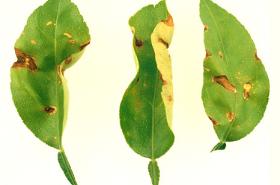


Anthracnose (Colletotrichum spp.)
There are 3 anthracnose diseases of citrus caused by Colletotrichum spp. Post-bloom fruit drop, which affects flowers of all citrus species and induces drop of fruitlets and is caused by C. acutatum. Lime anthracnose, which attacks all juvenile tissues of only Mexican lime, is also caused by this Colletotrichum species. C. gloeosporioides causes a rind blemish on fruit, especially grapefruit, in the field.
Post-bloom fruit drop
Description: C. acutatum infects petals and produces water-soaked lesions that eventually turn pink and then orange brown as the fungus sporulates. Infected fruitlets abscise at the base of the ovary, and the floral disk, calyx, and peduncle remain attached to the tree, forming structures commonly referred to as 'buttons'. Leaves surrounding an affected inflorescence are usually small, chlorotic, and twisted and have enlarged veins. Warm, wet weather favours disease development.
Lime anthracnose
Description: It affects only Mexican lime. It attacks flowers, young leaves, young shoots and fruits. Infected fruitlets abscise, and 'buttons' are produced as in postbloom fruit drop. In severe cases, young leaves become totally blighted and drop, and shoot tips die-back, producing wither tip symptoms. The fruit lesions are often large and deep, and cause fruit distortion. The disease is favoured by warm, wet weather.
Rind blemish on fruit
Description: The disease is caused by C. gloeosporioides. It is particularly severe on grapefruits. The blemish appears as a superficial, reddish brown discolouration, often in the form of tear stains, which usually appears following prolonged light rains in warm weather.
- Avoid overhead irrigation (opt for under-tree sprinklers where feasible)
- Wide tree spacing to reduce relative humidity within tree canopy
- Pruning of dead tree tissues
- Copper preventive sprays
